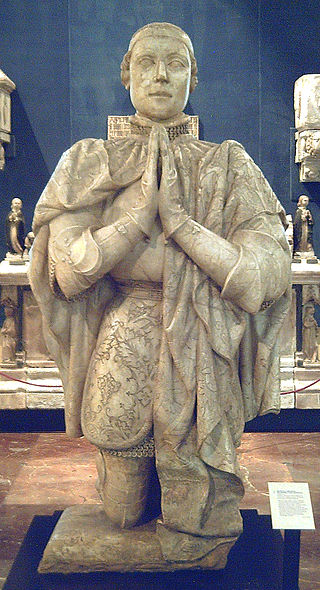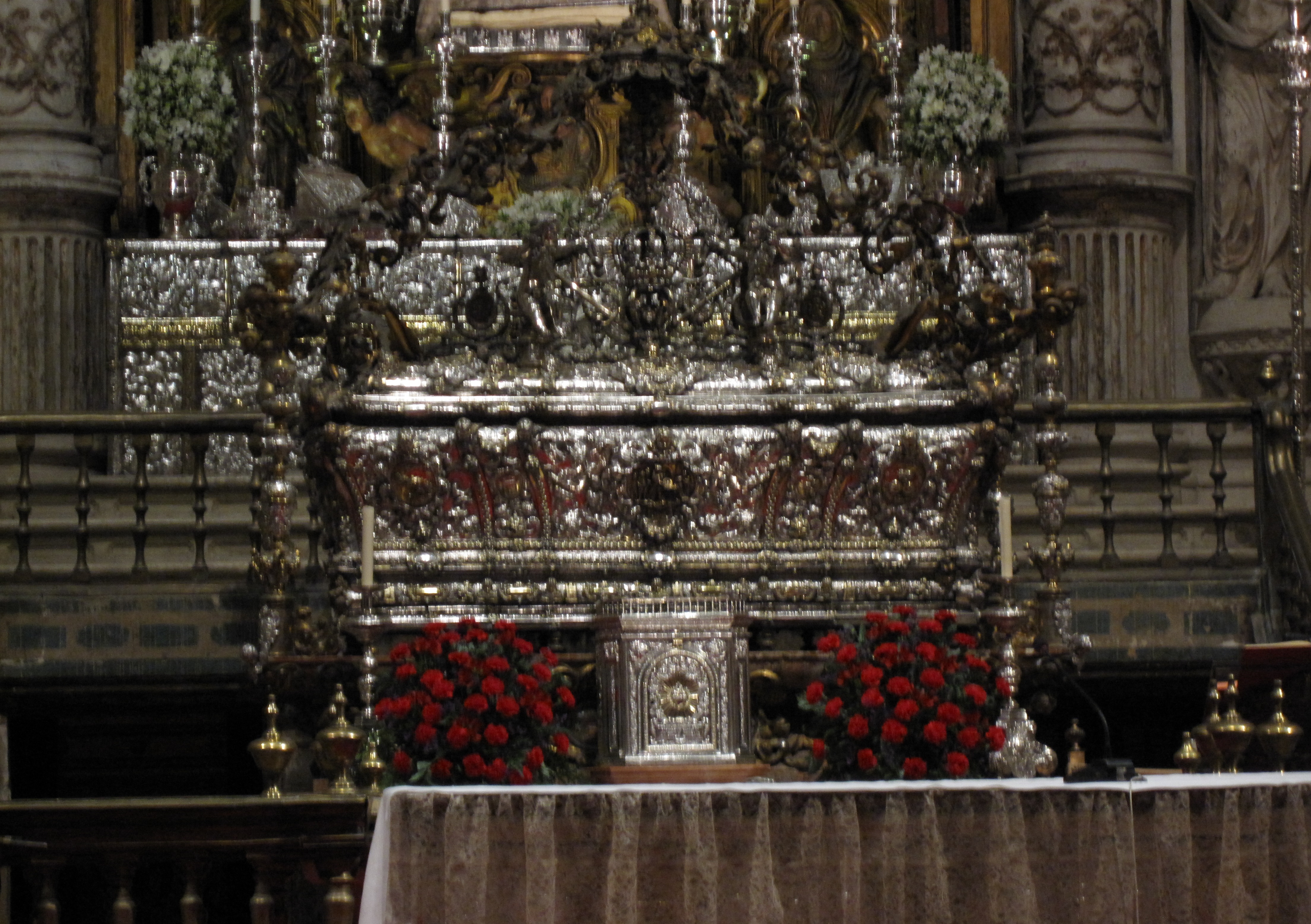Peter was born in the defensive tower of the Monasterio de Santa Maria la Real de Las Huelgas in Burgos, Spain.
Peter began his reign when he was only sixteen years old and subjected to the control of his mother and her favourites. He was to marry Joan, daughter of Edward III of England; on her way to Castile, however, she travelled through cities infested with the Black Death, ignoring townspeople who had warned her not to enter their settlements. Joan soon contracted the disease and died.
Though at first controlled by his mother, Peter emancipated himself with the encouragement of the minister Albuquerque. Becoming attached to María de Padilla, he married her in secret in 1353.
In the summer of 1353, the young king was practically coerced by his mother and the nobles into marrying Blanche of Bourbon; he deserted her at once. This marriage necessitated Peter's denying that he had married María, but his relationship with her continued and she bore him four children. He also apparently went through the form of marriage with a lady of the family of Castro (who bore him a son who died young, after Peter's death), then deserted her.
Queen Blanche died at Medina Sidonia. Legend claims that Peter murdered her: one version of the story says she was poisoned, another that she was shot with a crossbow.
In 1366 began the calamitous Castilian Civil War, which would see him dethroned. He was assailed by his bastard brother Henry of Trastámara at the head of a host of soldiers of fortune, including Bertrand du Guesclin and Hugh Calveley, and abandoned the kingdom without daring to give battle, after retreating several times (first from Burgos, then from Toledo, and lastly from Seville) in the face of the oncoming armies. Peter fled with his treasury to Portugal, where he was coldy recieved by his uncle King Peter I of Portugal.
On March 14, 1369, the forces of Peter and Henry met at Montiel, a fortress then controlled by the Order of Santiago. Henry prevailed with the assistance of Bertrand du Guesclin. Peter took refuge in the fortress, which, being controlled by a military order of Galician origin, remained faithful to him. Negotiations were opened between the holed-up Peter and his besieger, Henry. Peter met with du Guesclin, who was acting as Henry's envoy. Peter appealed to du Guesclin's well-known treacherous side.
He offered du Guesclin 200,000 gold coins and several towns, including Soria, Almazan, and Atienza to betray Henry. Ever vigilant in his opportunistic ways, du Guesclin informed Henry of the offer and immediately bargained for greater compensation from Henry to betray the conspiracy proposed to him by the isolated monarch.
Having made a deal with Henry, Du Guesclin returned to Peter. Under the guise of accepting his proposal to betray Henry, du Guesclin led Peter to his tent on the night of March 23, 1369. Henry was waiting. The historian Lopez de Ayala described the encounter as follows:
Upon entering du Guesclin's tent, Henry "saw King Peter. He did not recognize him because they had not seen each other for a long time. One of Bertrand's men said 'This is your enemy.' But King Henry asked if it was he and . . . King Peter said twice, 'I am he, I am he.' Then King Henry recognized him and hit him in the face with a knife and they . . . fell to the ground. King Henry struck him again and again."
Having dispatched his half-brother, Henry left Peter's body unburied for three days, during which time it was subjected to ridicule and abuse.
Peter's children by María de Padilla were:
Beatrice (1353–1369), nun at the Abbey of Santa Clara at Tordesillas
Constance (1354–1394), married John of Gaunt
Isabella (1355–1392), married Edmund of Langley
Alfonso (1359–1362), Crown Prince of Castile and León (Tordesillas, 1359 – 19 October 1362). Peter forced the Cortes to recognize Alfonso as his legitimate heir on 29 April 1362. However, Alfonso, a very sickly child, died at the age of three, months from his recognition as Crown Prince.
Peter had one son with Juana de Castro:
John (1355–1405), married doña Elvira de Eril, had issue
Peter was born in the defensive tower of the Monasterio de Santa Maria la Real de Las Huelgas in Burgos, Spain.
Peter began his reign when he was only sixteen years old and subjected to the control of his mother and her favourites. He was to marry Joan, daughter of Edward III of England; on her way to Castile, however, she travelled through cities infested with the Black Death, ignoring townspeople who had warned her not to enter their settlements. Joan soon contracted the disease and died.
Though at first controlled by his mother, Peter emancipated himself with the encouragement of the minister Albuquerque. Becoming attached to María de Padilla, he married her in secret in 1353.
In the summer of 1353, the young king was practically coerced by his mother and the nobles into marrying Blanche of Bourbon; he deserted her at once. This marriage necessitated Peter's denying that he had married María, but his relationship with her continued and she bore him four children. He also apparently went through the form of marriage with a lady of the family of Castro (who bore him a son who died young, after Peter's death), then deserted her.
Queen Blanche died at Medina Sidonia. Legend claims that Peter murdered her: one version of the story says she was poisoned, another that she was shot with a crossbow.
In 1366 began the calamitous Castilian Civil War, which would see him dethroned. He was assailed by his bastard brother Henry of Trastámara at the head of a host of soldiers of fortune, including Bertrand du Guesclin and Hugh Calveley, and abandoned the kingdom without daring to give battle, after retreating several times (first from Burgos, then from Toledo, and lastly from Seville) in the face of the oncoming armies. Peter fled with his treasury to Portugal, where he was coldy recieved by his uncle King Peter I of Portugal.
On March 14, 1369, the forces of Peter and Henry met at Montiel, a fortress then controlled by the Order of Santiago. Henry prevailed with the assistance of Bertrand du Guesclin. Peter took refuge in the fortress, which, being controlled by a military order of Galician origin, remained faithful to him. Negotiations were opened between the holed-up Peter and his besieger, Henry. Peter met with du Guesclin, who was acting as Henry's envoy. Peter appealed to du Guesclin's well-known treacherous side.
He offered du Guesclin 200,000 gold coins and several towns, including Soria, Almazan, and Atienza to betray Henry. Ever vigilant in his opportunistic ways, du Guesclin informed Henry of the offer and immediately bargained for greater compensation from Henry to betray the conspiracy proposed to him by the isolated monarch.
Having made a deal with Henry, Du Guesclin returned to Peter. Under the guise of accepting his proposal to betray Henry, du Guesclin led Peter to his tent on the night of March 23, 1369. Henry was waiting. The historian Lopez de Ayala described the encounter as follows:
Upon entering du Guesclin's tent, Henry "saw King Peter. He did not recognize him because they had not seen each other for a long time. One of Bertrand's men said 'This is your enemy.' But King Henry asked if it was he and . . . King Peter said twice, 'I am he, I am he.' Then King Henry recognized him and hit him in the face with a knife and they . . . fell to the ground. King Henry struck him again and again."
Having dispatched his half-brother, Henry left Peter's body unburied for three days, during which time it was subjected to ridicule and abuse.
Peter's children by María de Padilla were:
Beatrice (1353–1369), nun at the Abbey of Santa Clara at Tordesillas
Constance (1354–1394), married John of Gaunt
Isabella (1355–1392), married Edmund of Langley
Alfonso (1359–1362), Crown Prince of Castile and León (Tordesillas, 1359 – 19 October 1362). Peter forced the Cortes to recognize Alfonso as his legitimate heir on 29 April 1362. However, Alfonso, a very sickly child, died at the age of three, months from his recognition as Crown Prince.
Peter had one son with Juana de Castro:
John (1355–1405), married doña Elvira de Eril, had issue
Gravesite Details
The tomb has not been preserved.














